Yeah, so how about that Blade Runner: The Final Cut article in the Arts & Leisure section??
September 2007 Archives
September 29, 2007
HOLY CRAP, FRED KAPLAN, SPOILER ALERT?!
September 29, 2007
Dara Friedman's Musical
Dara Friedman is unobtrusively videotaping people singing show tunes in public in New York City for a project commissioned by the Public Art Fund:
The policeman on the staircase barely looks up; the two little girls beside him continue giggling about whatever it was they had been giggling about.Turning All of Manhattan Into A Broadway Stage [nyt]“For a second,” Ms. McLean said afterward, “you’re like, ‘Am I doing this in my head or am I doing this?’”
She walks down the stairs and hits a crescendo: “‘Romance is mush/Stifling those who strive/ I’ll live a lush life in some small diiiiive. ...’”
Two businessmen glance at each other cynically and keep walking. An unkempt woman stops to offer compliments. Two tourists look around, see no reaction and walk on. And those are the ones who are paying attention.
For a few minutes it’s as if everyone in Grand Central is actually in a musical, where somebody singing about unrequited love makes more sense than somebody not singing about it.
September 28, 2007
The Trailer's Up For The New Sony Bravia Ad
Yes, a commercial has a making of trailer. The premiere is October 5th.
NY: Play-Doh [bravia-advert.com via coudal]
Previous Bravia bravado; also prior art on the 'lots of bouncing balls' concept
September 27, 2007
Saffron Revolution Stencil

A support campaign for the marching monks of Burma, including this stencil, which is downloadable as a pdf [saffronrevolutionworldwide.blogspot.com via monoscope]
September 22, 2007
John Cage's Chess Pieces

I've been listening to WNYC's anniversary tribute programming for John Cage, and it's really great [if a bit over-narrated; I mean, who's going to listen to 24h33m of John Cage programming on-demand who isn't at least somewhat familiar with his work already?]
One 1944 composition, Chess Pieces, was only rediscovered and played for the first time in 2005.
Cage had been invited to participate in a chess-themed exhibit at the Julian Levy Gallery organized by Max Ernst and Marcel Duchamp, and he created a chessboard-sized painting with fragments of musical scores in each of the squares. Each square held about twelve measures in three rows. The painting went into a private collection where it remains, almost completely invisible to the outside Cageian world until 2005, when the Noguchi Museum recreated the 1944 exhibit, "The Imagery of Chess." [Noguchi had contributed a chess set to the show, as did artists such as Man Ray and Alexander Calder.]
Anyway, Cage pianist Margaret Leng Tan was commissioned to transcribe and perform the score in the painting, which premiered alongside the 2005 exhibit. The DVD of the Chess Pieces performance includes several other Cage sonatas and some short-sounding documentaries, including one about the history of the work. Not sure what that means.
As a painting, the collaged, juxtaposed chaos of the notes contrasts with the order of the grid. It kind of reminds me of the cut-up technique William Burroughs and the Beats' applied to books and printed texts a few years later. [The history of cut-up mentions an interesting, even earlier reference: Dada pioneer Tristan Tzara, who was expelled from Breton's Surrealist movement when he tried to create poetry by pulling words out of a hat.]
As a musical composition, Chess Pieces is nice, old-school Cage, abstract and occasionally abrupt, but with a still-traditional piano feel. Since the piece's randomness comes from its structure--the distribution of the notational fragments across the grid--and not from the performer's own decisions, it somehow has a "composed" feeling to it. So though it's new to audiences today, it's also classic, early Cage.
September 22, 2007
"the artist known as Mr. Prince"

Randy Kennedy has a great, if slightly artificially naive, article on Richard Prince, whose retrospective opens at the Guggenheim next week. Despite curator Nancy Spector's play-along comments to the contrary, Prince's "readymade" edition of three custom-built replicas of a 1970 Dodge Challenger does not, in fact, push "the art-or-not-art question up to its breaking point"; it's a question that's been asked and answered long, long ago, when Duchamp had his first readymades custom-fabricated:
Mr. Prince said he was still not quite sure what to consider the car, although he does plan an edition of three, and he thinks of the first one, recently completed for him by XV Motorsports in Irvington, N.Y., a high-end builder of modernized muscle cars, as an artist’s proof. (Its first appearance will be at the Frieze Art Fair next month in London, where the car was recently shipped.)Still, it's interesting to read that Prince's bio may be equally conceptual, i.e., fabricated, even on the basics. Says Spector, "only half-jokingly: 'His real name might not be Richard Prince. It’s entirely possible.'"Aside from minor customizing Mr. Prince asked for, the car is identical to an earlier Challenger XV made using vintage shells but filling them with new high-performance engines, suspension and steering. (The company’s prices start at $140,000.)
“I kind of agreed with the look of the car they had put out,” Mr. Prince said, adding that he also liked the custom color XV had already mixed for the car, a yellowish orange he calls “Vitamin C.”
On later versions, he said, he might customize the gas cap, headrests, upholstery and other parts of the car with his artwork. But for now a mean ride is being declared a kind of street-legal ready-made basically because Mr. Prince is in love with the way it looks — and the way, as with many of the appropriations in his art, it reflects American desires and dreams, particularly those of his youth in the tumultuous 1960s and ’70s.
I'm not not a fan of Prince's work, but it has sure been the subject of a heap of art world/ market insider giddiness the last few years. Talking about the cars, Spector says "the critical function" may not have "caught up to" Prince's work yet. And given her own coyness about insuring the car as a car or a work of art, and her apparent complicity in treating nominally verifiable facts as performative fiction, I can't imagine much "critical function" in the Guggenheim show, either. Full credit to Randy for the headline quote above, though.
September 16, 2007
Cuantos Obeliscos Portables? Mas, Por Favor!
Have Mexican artists ever met an obelisk they didn't want to make portable and drive to New York?
Obelisco Transportable, 2004, Damian Ortega, on view with the Public Art Fund, thru 10/28 [image: Ortega's gallery, kurimanzutto]:
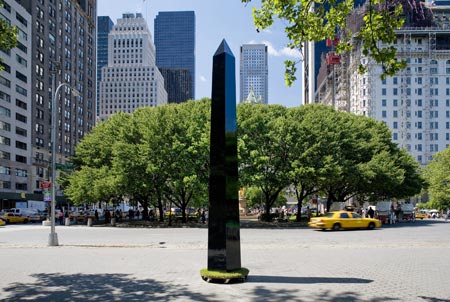
Portable Broken Obelisk (for outdoor markets), 1993-4, Eduardo Abaroa, on view at"Mexico City" @ PS1, Summer 2002 [image: Abaroa's gallery, kurimanzutto]:
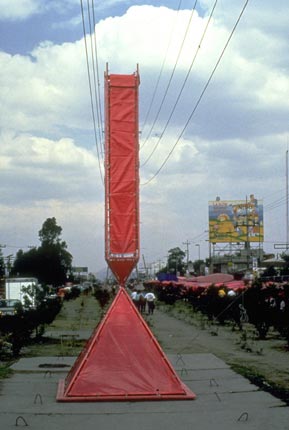
from Pruned:
We can't help here suggesting that Ortega should give Ikea permission to mass produce and sell his reusable memorials, because, firstly, we like to imagine them multiplying exponentially in public spaces everywhere (and no, there is still not nearly enough memorials), and, secondly, we also like the image of people scouring the city--a sort of pre-funerary cortege mixed in with some urban sightseeing--for an abandoned obelisk, one commemorating something already forgotten in the collective memory.
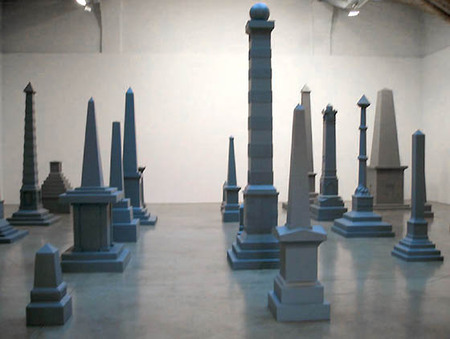
2016 update: I'm re-reading this in preparation for linking to it, and I cannot figure out wtf I meant by that last line, about Indians being brown. Maybe it was a reference to the "White and Indian" in Durant's title? I have no idea, but reading it cold right now, it sounds more racist, certainly more insensitive, than I would have thought at the time. Time does that, I guess.
September 15, 2007
Have You Seen Me? Warhol's Lost Videos

still from Inner and Outer Space, 1965
Fascinating. In 1965, months before pioneering video artist Nam Jun Paik got his hands on his own first video camera, Norelco loaned Andy Warhol its new, $3,950 slant scan video recording system for a month. [1] At the time, Sony, Ampex & others had just released the $1,000 VTR systems. Paik started using the Sony Video Rover Portapak almost as soon as it hit the market. Tape Recording magazine's [!] interview with Warhol about the video system is included in Kenneth Goldsmith's 2004 collection of Warhol interviews, I'll Be Your Mirror.
While he had the camera, Warhol made Inner and Outer Space, an important, multiscreen portrait film of Edie Sedgwick where she sits in front of a video monitor that's playing back a videotaped portrait of herself.
Here's Callie Angell of the Warhol Film Project in a 2002 article for Millennium Film Journal:
During the month that Warhol had this video access, he shot approximately 11 half-hour tapes (at least, that’s how many Norelco videotapes have been found in the Warhol Video Collection). One of the interesting things about Outer and Inner Space is that it contains, in effect, the only retrievable footage from these 1965 videotapes. The Norelco system utilized an unusual video format, called “slant scan video,” which differed from the helical scan format [2] developed by Sony and other video companies, and which very quickly became obsolete. There are now no working slant scan tape players anywhere in the world, the other videotapes which Warhol shot in 1965 cannot be played back, and the only accessible footage from these early videos exists in this film, which Warhol, in effect, preserved by reshooting them in 16mm. [emphasis added]What might be on the other nine Warhol tapes? From clues in the Tape Recording interview, they range from the Mel Gibsonian to the ur-video artistically Naumanian to the classically Warholian:
Warhol:...It's the machine we're going to use to do our 31-day movie.As it's being restored and re-seen, Andy Warhol's early films are turning out to be central to his explorations of serial imagery, mechanical reproduction, celebrity, and portraiture, not a diversion from his "real" or "important" painting work. [For more discussion of this, check out Angell's text for a 2001 exhibit of Inner and Outer Space at ZKM in Germany.]TR: What?
Warhol: It's the story of Christ.
...
TR: Have you recorded from a television set with the video recorder?
Warhol: Yes. This is so great. We've done it both direct and from the screen. Even the pictures from the screen are terrific. Soemone put his arm in front of the screen to change channels while we were taping and the effect was very dimensional...
...
TR:...Have you been trying to do things with tape that you can't do with film?
Warhol: Yes. We like to take advantage of static. We sometimes stop the tape to get a second image coming through. As you turn off the tape it runs for several seconds and you get this static image. It's weird. So fascinating.
...
TR: Is it that easy out-of-doors, too?
Warhol: Yes. We took the recorder onto our fire escape to shoot street scenes.
TR: What did you get?
Warhol: People looking at us.
This is not exactly new news, of course. [As David Hudson said in 2002, "the paintings are everywhere the films are nowhere."] But I would say it's also not reflected in the popular, i.e., market view of Warhol, precisely because the film works like Screen Tests can't be collected and thus don't command attention-getting auction prices.

image: Holly, 1966 via christies
Imagine the treasure hunt if it were nine 1965 Warhol paintings known to be missing, extant but unseen. When video arcade hardware went obsolete, emulation software emerged to preserve the important part--the gameplay. Maybe some video gearhead or codec master somewhere will undertake the quixotic but art historically important mission of decoding slant-scan videotape and recovering these lost Warhol tapes.
[1] Hmm, another account of the Norelco loan describes the VTR as a prototype. And LabGuy's timeline of Extinct VTR Formats doesn't even mention a Norelco product until 1970.
[2] Hmm, according to this UBuffalo history of the videocassette, slant-scan and helical scan are the same thing.
September 14, 2007
On The Mixed Up Films Of Mr. Andy Warhola

Wait, the Warhol Museum called the 1-hour excerpt of Empire released on DVD an unauthorized bootleg?
Yes they did, in 2004:
"It's a bootleg!" says Geralyn Huxley, a curator at the Andy Warhol Museum in Pittsburgh.Which is odd. The Italian company Raro Video has released several Warhol films on DVD over the last couple of years. Andy Warhol: 4 Silent Movies is listed as a 2005 release on Amazon, and there's a Chelsea Girls DVD, too.
Last year, Raro compiled 11 films and 8 discs into a box set, Andy Warhol Anthology, which--like all the films--is issued in region-free PAL format. There are extensive bilingual notes, interviews, and bonus material accompanying the discs, but there are also odd errors in formatting:
At least two of the silent films, Kiss and Blow Job, are mastered at the wrong speed [25fps instead of 16fps], and the once-randomly silent or audible soundtracks on the split-screen Chelsea Girls are provided in a single, seemingly arbitrary configuration which omits much well-documented dialogue
Despite these apparent errors, Raro insists that its films are authorized versions, not bootlegs, and that the errors were present in the master versions provided by the Warhol Foundation [which is distinct from the Warhol Museum].
A film director, critic, historian, I-don't-know-what named Mario Zonta is described as both the organizer of the Anthology and a "Member" of the Warhol Foundation. [Zonta, a longtime friend of Warhol entourage members/collaborators Joe Dallesandro and Paul Morrissey, also made a Morrissey documentary in 2002 which is included in Raro's Dallesandro/Morrissey trilogy.]
According to an extensive discussion on Criterion Forum about public availability of Warhol's films generally and the legal/definitive status of the Anthology specifically, Raro has long had VHS distribution rights to some Warhol titles and is merely updating the format.
After Warhol gave copies of all his film materials to MoMA in 1984, the Whitney Museum and MoMA have been jointly cataloging, restoring, and re-issuing Warhol films [for institutional use] under the Andy Warhol Film Project. From the Whitney description of the project, though, the existence of a traditional commercial "distribution" deal for Empire sounds very improbable:
In 1970, the artist withdrew his films from distribution; for the next twenty years, most critics and scholars could only reconstruct these works from reviews and other verbal accounts.While it was screened soon after it was made in 1964, Empire was only shown in its restored entirety thirty years later, in 1994.
When asked in 2004 about the Raro DVD, Film Project director Callie Angell said Empire could not be cut. "It's conceptually important that it's eight hours long...Some people show it at the regular sound speed to make it go by faster, and I just think that's not the film."
And yet, in 2002, artist Donald Moffett put together a wonderful show called "Vapor" at Marianne Boesky Gallery, where he projected a 50-minute excerpt of Empire. I can't remember now, but it feels like it was a single film reel of Empire on a loop, not a DVD. No one raised any objections to what seemed like excerpting for purely logistical, practical reasons.
And last spring, MoMA itself exhibited a 2h24m excerpt of Empire in the gallery of its theme show, "Out of Time: A Contemporary View" [the full 8:05 version was screened in the theater.] Here's a description of what Empire's making and makeup:
Empire consists of one stationary shot of the Empire State Building taken from the forty-fourth floor of the Time-Life Building. Jonas Mekas served as cameraman. The shot was filmed from 8:06 p.m. to 2:42 a.m. on July 25-26, 1964. Empire consists of a number of one-hundred-foot rolls of film, each separated from the next by a flash of light. Each segment of film constitutes a piece of time. Warhol's clear delineation of the individual segments of film can be likened to the serial repetition of images in his silkscreen paintings, which also acknowledge their process and materials.At 40 frames/foot and 2:45 minutes/roll of shooting time over 7h36 minutes, that'd be at least 144 rolls of film. But according to the making of account on WarholStars.org, the Auricon camera they used was chosen because it had a 1200' magazine, which cut way down on the number of changes required. Incidentally, Warhol almost never touched the camera during the entire 6.5-hour shoot. Instead, Gerard Malanga, Jonas Mekas, and John Palmer [who's credited with the idea for Empire] ran the shoot while Warhol and several other folks watched.
 Without having seen any of the DVD versions of the films yet, I would suspect that as a member of the Warhol orbit, someone like Mario Zonta would own--or have access to--period prints that predate MoMA's involvement and the Foundation's and the Museum's creation.
Without having seen any of the DVD versions of the films yet, I would suspect that as a member of the Warhol orbit, someone like Mario Zonta would own--or have access to--period prints that predate MoMA's involvement and the Foundation's and the Museum's creation.
And while those institutions may assert control over the intellectual property rights of the films, their claim would be contingent on Warhol's and the films' compliance with the copyright laws in effect when they were made. If a studio film like Stanley Donen's Charade can inadvertently slip into the public domain for failing to meet copyright filing standards, I'd bet that most of Warhol's films could easily be in the public domain, too.
The Warhol Foundation's apparent involvement in the "bootleg" versions is made more interesting by their extremely controversial actions in authenticating Warhol's work. On the Criterion forum, several people commented on the Foundation's approach to the films as art, not "films" as a way to explain their distribution questions.
If the Foundation actually released or authorized error-laden versions of the films, it would be an utter failure of their responsibility to the authenticity of Warhol's work. Many Factory regulars talked to Anthony Haden-Guest about the importance of Warhol's films and their own experiences posing for the seminal Screen Tests:
Irving Blum says Warhol did not take his films lightly. 'At the beginning he was far more revealing than he was post the shooting,' Blum says. 'If you had him alone, if he wasn't performing, he was incredibly interesting to talk to. What he was doing was, in his terms, recapitulating all of cinema. Doing it single-handedly, starting from the beginning, and working in a parallel way to real cinema. It was nothing less than the most heroic task. And, as frivolous as some of the movies were, he thought of them very seriously.'I've never heard of Warhol considering his films to be works, at least in the sense of editioning and selling them.
Just the opposite, in fact. As he explained in a 1966 interview for Cavalier magazine, he saw the films as distinct from his paintings and treated them as traditional, commercial films:
Cavalier: Do you want a lot of people to see your films?But what if their very nature makes them the ultimate expression of Warhol's pop, serial ideas? Why shouldn't a period print of a Warhol film turn out to be as valuable and collectible as a Factory-produced silkscreen--assuming the Foundation doesn't arbitrarily declare it "inauthentic," of course?Warhol: I don't know. If they're paying to see them. By the way, they can be rented. There's a catalog, and the cost is nominal: one dollar per minute. A 30-minute film rents for $30. Sleep rents for $100, at a special rate. And you can get all eight hours of Empire for $120.
Cavalier: A lot of people have said that these are pretty boring films.
Warhol: They might be. I think the more recent ones with sound are much better.
Whatever the case, there are excruciatingly few ways to see Warhol's films at all, and with no indication that MoMA or the Warhol Museum is planning to make definitive, commercial versions available to the public, a $145 PAL box set is about as good as it's gonna get for a while.
A Controversy Over 'Empire' [nymag via kottke]
Buy Raro Video's Andy Warhol Anthology on eight Region-0 PAL DVD's, EUR99 now EUR63! [rarovideo.com]
Andy Warhol [criterionforum.org]
Factory Fresh [guardian.co.uk]
Previously: The Fake Andy Warhol Lectures
September 14, 2007
Gregger Stalker

So someone on Gawker thought they just saw Tripp Darling eating at 63rd & 5th?
No way! That's so funny! Because I thought I just saw the pantsless pothead professor from Animal House! But it wasn't 63rd & Fifth; it was in Jed Clampett's old place. Either way, dude's looking O-L-D.

September 13, 2007
Any Club That Will Have Me As A Member
The Internet is a series of tubes.
Also, the art world is a series of dinner parties.
My favorite out-of-nowhere aphorism: "Forget about one-on-one art. This fall, elitism will find its feet in a rush of exclusive, invitation-only performances, like Damien Hirst’s debut as a fashion designer, at Gagosian on Saturday night."
Spectator Sport by Linda Yablonsky [artforum]
September 8, 2007
Seriously, People, He Did Not Get A $100 Million Check For The Skull
I continue to be baffled by the breathlessly uninformed reportage of the supposed sale of Damien Hirst's diamond-and-platinum skull. From the very first news report of the sale in the Evening Standard journalists have gotten it wrong, and everyone else happily repeats the unsupported headline ["Investment group pays £50m cash for Hirst's diamond skull"], as fact, despite plenty of information to the contrary.
If the media and its reflexive echoes through the audience are so easily gulled on something irrelevant, like a diamond skull, what would happen if a serious issue of global importance came along, like someone trying to start a series of wars across the Middle East? [oh wait...]
Forget Carol Vogel's buried bombshell today that the skull is actually an edition of three. Has anyone ever mentioned that before, anywhere? I'm a collector of $100 million sculptures, I want to know if it's unique or a multiple, it's not a trivial question. But whatever.
Forget the persistent claims that it cost $25 million to build. For one thing, it was first reported to cost $20 million to build. Is the difference in reports from the same sources due to late-arriving invoices from the diamond guy? Are they expensing the cost of marketing and security for the show? Is it the heinous-and-getting-worse dollar/pound exchange rate? Or is it willfully and strategically inflated and or shifting claims on the part of Hirst & Co?
First reports from two weeks ago said the sale would close "in three to four weeks," and that Hirst has "has retained a stake to keep some control over what happens to it." Based on a conversation with Hirst manager Frank Dunphy, Bloomberg reported "the price hadn't been discounted and would be paid in cash, though he wouldn't say over what period, or identify the investment group."
If an "investment group" is involved, why not try discussing the deal as if it were any other private equity investment? Consider Hirst as launching a start-up. He invested his own seed capital to make the skull. I'll be generous and say it was $15 million. He has 100% of the skull for $15 million.
Now he brings it to Jay to sell. They say it's now worth $100 million. If it were any other work or any other artist, Jay would take a 50% cut of the sale price, $50 million. But that means Damien would only net $35 million. While I'm sure it's good to be Jay, it's not that good. Jay will get a nice piece of the sale of the thousands of prints, but let's say he only gets 10% of the sale, or $10 million. Now two people have stakes in the skull, though: on paper at least, Damien's $15 million investment is already worth $90 million.
The NYT reports that dealer Alberto Mugrabi's offer of $50 million was refused. No duh. VC money is always expensive, and if you don't need it, don't take it. Mugrabi would've doubled his money on paper instantly, paying just $50mm for a perceived-$100mm work, while Hirst would've netted a mere $30 million [$50 - 5 -15], a return of just 100%. [Note, if the skull actually did cost $20-25 million to make, Hirst's return would've been even worse. Either way, though he thinks his reported offer makes him a player, Mugrabi comes off looking like a lowballing goof.]
But now we come to the "investment group," whose ownership stake in the skull and the price they're paying for it is undetermined. All we know is that the deal gets done at a valuation of $100 million. With two unknown variables, it could literally be anything: $10 million for a 10% stake, $50 million for 50%, etc.
Let's look at one possible scenario, that an investor takes a quarter of the skull and lets Hirst and Jopling pull their own initial investments out: $25 million. Which leaves Hirst with a $75 million stake and control of the skull, which he'll continue to promote around the world. In 2-3 years, after the tour ends, they can sell the skull, or bring in another round of investors at a [hopefully] higher valuation.
Another scenario hinted at by the non-disclosure to Bloomberg is payments over time. Maybe the deal lets Hirst pull his cash out now--$15 million-- and has an earn-out, another payment after the tour, either at the same or a higher valuation.
Jopling could keep his skin in the game, too, by converting his $10 million owed into equity [I would hope he'd get a discount, or at least a nice friends & family offering price, but who knows?]
Since the possibility was raised and not answered, I would guess there's a payment schedule involved. If a deal goes through, it'd probably give Hirst at least an immediate 100% return on his investment, i.e., $30-50 million, for a commensurate share in the skull, with additional payments along the way and/or a nice post-tour bonus/buyout option.
The most aggressive scenario may be the first one reported in The Art Newspaper, which had the skull's price discounted about 20-25% to from 50 to 38 million pounds, $76 million. If this were the offer, and Hirst wanted to preserve the $100 mm valuation, his and Jopling's stakes would be 25%, roughly what they "put in."
Then the question arises again of the timing of the payments. The $100mm price could just as easily be the future value of a series of payments which could total $100mm, but because of the time value of money, would be--aha--discounted to the present value. The most familiar--and in this case, perhaps most appropriate--example of this is the lottery; the $330 million in the US news recently had a lump sum payment of $197 million, 59% of the "value."
By fixing only the announced price and leaving almost every other variable on the table, the transaction value of Hirst's skull could literally be almost anything. The whole exercise exposes the content-free ridiculousness of public obsession with the price of a work of art, especially as an indicator of its importance. [Or rarity. Remember, it's now an edition of three. Are there any artist proofs?]
Or maybe there's a more conceptual explanation. Duchamp opened the door for art to be whatever an artist declares it to be. Perhaps Hirst is simply extending that practice to the work's price as well. Price is not an object, it's the subject. The essence of the work exists in the deal's spreadsheet and term sheet, a score for a multi-year performance of wire transfers and receipts that plays out while most people are distracted by the shiny object.
September 7, 2007
"Or, More Precisely, Flexibility Is Itself A Singular Aesthetic."

For some reason, I was thinking of totally livable, modernist gas stations yesterday [actually, it was because I heard fellow prefab gas station fan Mister Hoopty on the radio] and so I started digging, trying to find out more about Clauss & Daub, the architects of the 1931 porcelain-enameled steel Sohio station that Philip Johnson included in The International Style, his and H.R. Hitchcock's era-defining exhibition/catalogue. [above]
Turns out there's very little info at all online, except some references to the duo in an Architronic reminiscence of Cleveland. But it also turns out that Johnson was instrumental in getting his Mies-connected colleagues in touch with Standard Oil in the first place, via his own well-connected father. 40-200 of the Clauss & Daub stations were planned, but I have no idea how many were built or if any survive.
The idea of hanging industrial/commercial grade enamel, steel, and glass on steel girders fresh in my mind, I saw MDesign's MCube Modular Prefab System as a tantalizing update of the technology that I could yield a fine, gas station-like home without the environmentally catastrophic site issues.
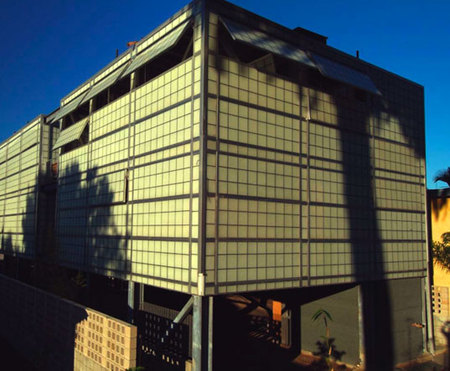
The MCube is based on a 10-foot post&beam module that's endlessly flexible [sic] and affordable [$80/sf!], and Inhabitat's description of Mark Baez's design is unusually upbeat, even for Inhabitat:
Because the panels are translucent like Japanese shoji screens, rather than transparent like glass, they also protect privacy and block views into the interior. Better yet, each daylighting panel is moveable/operable like a shutter, allowing the occupants to open up any part of their little cube in order to let in the breeze. There aren’t any real glass “windows” per se in the house, but since each and every wall is essentially a window, there is no reason for separate windows in a house like this. To top it all off, the movable/removable wall panels allow for transformable space, so you can enjoy an ever-changing domestic space for years to come.No "windows" "per se"? No problem!

I'm sure Baez's patents are all in order, but a flexible, affordable, extruded aluminum cube-module-based house sounds almost exactly like George Nelson's once-famous Industrialized House, which he proposed in 1958.
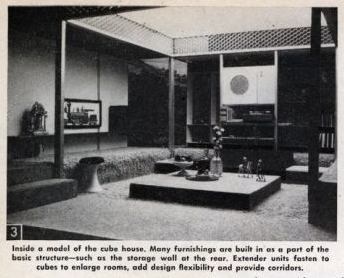
[The web dates this house to 1960, but only because that's when Science and Mechanics Magazine published it. Architecture & Building had actually covered it two years earlier. It's also depicted on the cover of Stanley Abercrombie's monograph, George Nelson: The Design of Modern Design, too.]

While being entranced by the Industrialized House a few months ago, I came across Mark Wigley's discussion of the promise and reality of "total design" in an old Harvard Design Magazine. Wigley cited Nelson's House, but he could just as easily be talking about the MCube, or any one of a dozen new prefab "systems":
Clearly, the dream of the total work of art did not fade in modernism’s wake. On the contrary, all of the issues raised by architects and theorists of recent generations that seem, at first, to signal the end of the idea of the total work of art turn out to be, on closer look, a thin disguise of the traditional totalizing ambitions of the architect.So I can't hang a painting or look out a window because of "the totalizing ambitions of the architect"?Fresh Herrings
Consider “flexibility,” the idea of an architecture that could assume any particular arrangement. Most flexible projects turn out to have inflexible aesthetic agendas. Or, more precisely, flexibility is itself a singular aesthetic. Look at the 1958 “Industrialized House” project by George Nelson, an architect who became famous as an industrial designer. The house is conceived as an industrial design product, a system of parts that can be infinitely rearranged. But Nelson never published more than one arrangement of the house, which included detailed color images of the model’s interior, complete with wall hangings, carpet, and dinnerware. At the very moment that he announces that the architect should provide only a framework for change, Nelson installs a total work of art. Likewise, Christopher Alexander’s 1977 A Pattern Language installs a singular aesthetic regime in the guise of a set of innocent building blocks that seem capable of infinite rearrangement. The last of these 253 “patterns” is an attack on “total design.” The hypocrisy of the attack is evident in the final lines that instruct the reader to hang personal things on walls rather than follow the dictates of designers. A designer claiming a total vision dictates that the totalizing instincts of all other designers should be resisted. The apparent flexibility of his system actually integrates all design into a transnational and “timeless” aesthetic pattern that can only be perceived by the master architect/manager. With systems theory, cybernetics, semiotics, and fractal geometry, the number of ways of absorbing difference into a singular structure continues to grow and to act as the totalizing architect’s best friend.
It seems almost easier--and more flexible--to rehab an old gas station.
Still, when an architect's designing an off-the-shelf cube home for himself, he can be as totalizingly ambitious as he wants. Ralph Rapson's family still uses the 1974 Glass Cube he built as their country retreat. It's 26 cubed feet of glass awesome. Materialicio.us just pointed to Architecture Week's excerpt on the Cube House's construction from Rip Rapson's book, Ralph Rapson: Sixty Years of Modern Design

September 4, 2007
Collecting Jackson Pollock
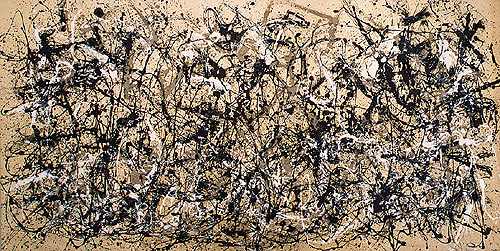
Ugh, Lee Rosenbaum's op-ed in the LA Times is so wrong in so many ways, even Tyler Green can't keep track of them all. She opines on the looming crisis facing museums ["Public collecting is endangered"!] who can't buy any more art because it's gotten too expensive:
It has always been hard for museums to compete with private collectors, but driven by the scarcity of great old works and an expanding class of wealthy buyers, the recent stratospheric rise of art prices has utterly outstripped most acquisitions budgets.It's hard to even refute her points because her data are so incomplete or contradictory; the only dire example she cites, $30 million/year for 45 departments at the Metropolitan Museum, are undermined by the Met's dramatic, opportunistic purchase of a $44 million Duccio using "timely" donations. As if donors willing to hand over that much money on a single ask just fall into a museum director's lap.
The risk museums face, Rosenbaum says, is that by not buying actively in the current contemporary market, they'll wake up fifty years from now, unable to afford this generation's Jackson Pollocks.
Had the Met followed that policy in 1957 [of not buying works from emerging or mid-career artists], it wouldn't have made its landmark purchase of "Autumn Rhythm" (1950) by Jackson Pollock. Just try buying a comparable Pollock in today's market, 50 years later, where one of his major works was reportedly sold by David Geffen for about $140 millionIn fact, the Met's Pollock acquisition is a perfect example of how ill-suited museums can be about collecting the work of contemporary and living artists. And the entry of iconic Pollocks into both the Met's and the Modern's collections show just how important trustee collectors have always been to building museum collections. The "crisis" Rosenbaum imagines now has existed almost from the founding of both these great American museums; they have almost always been too cheap, too slow, or too risk-averse to collect cutting-edge art, so instead, they collect collectors.
The Met bought Pollock's Autumn Rhythm [top] in 1957, the year after Pollock's death, and the year Frank O'Hara's mid-career survey of the artist at the Modern was tragically transformed into a retrospective. The Met paid $30,000 for the painting to Sidney Janis, a collector and dealer who'd shown it several times over the years, without being able to sell it anywhere.
In fact, Alfred Barr, the director of the Modern, had turned down the painting when his trustee, Janis, had offered it for sale for just $8,000 a couple of years earlier. Barr was unable to raise the money from his acquisitions committee for the still-controversial New York School work. Barr had the chance after Pollock's death, too, but balked again at the price, even though the work would be in the museum's own reputation-sealing exhibition.
The Met bought Autumn Rhythm using, not funds for contemporary art per se, but an acquisitions endowment set up by a turn-of-the-century trustee, George A. Hearn, for the acquisition of living, American artists. For the Euro-loving founders of the Met, American art was barely an afterthought before Hearn donated a core group of 27 works to found the American department. The history of the Met, in fact, can almost be told through its own, repeated, institutional failures to recognize the important art of the time, and its reliance on prescient trustees or formative private collections to rectify the situation. American, Impressionist, Pacific/Oceanic, Photography, all these departments were founded with the donation of significant private collections. [the link above is to an answers.com copy of the Met's wikipedia entry, which has mysteriously been cleansed of most critical accounts of its collecting history.

But back to Pollock and MoMA [where I should mention my longtime allegiances as a small-time fundraiser and supporter who most definitely does not write in any official capacity on these matters for the Museum. My knowledge comes from books by the likes of O'Hara, William Rubin, the art historian Irving Sandler, among many, many others, none of whom Ms. Rosenbaum seems familiar with, btw. Another good synthesis is "Selling American Art," Christine Bianco's 2000 MFA thesis at the University of Florida, which is a pdf here]:
Despite Janis's decades-long association with the Museum, MoMA's own iconic 1950 Pollock, One: Number 31, 1950 [above], only came into the collection in 1967, long after Barr had been replaced by William Rubin. Ironically, even at that point, Rubin had to raise the money to buy One from Janis by selling two paintings by Mondrian--two of five which Janis had donated in the first place. I say ironic because the other of Rosenbaum's laments is that museums are "selling to buy," deaccessioning works in order to buy other works.
Or to put it another way, had the Modern followed Rosenbaum's ideal policy in 1967, it wouldn't have made its landmark purchase of "One: Number 31, 1950" (1950) by Jackson Pollock. But hey, at least it'd have 45 Mondrians instead of the measly 43 it has now.
Finally, a cursory look at many of the labels of recent acquisitions at MoMA shows a credit to the Fund for the Twenty-First Century, which was established for the express purpose of buying current works by living, contemporary artists. In describing the Museum's contemporary acquisitions approach during a gallery talk at a recent recent acquisitions show, co-curator Klaus Biesenbach mentioned the hope that even 50 of the 1,000-plus new works the Museum buys each year would stand the test of time. I don't know what other museums would even want to collect at that pace or with those odds. The Guggenheim's 2003 show of photography and video, "Moving Pictures," was similarly put together almost entirely of new work entering the collection. So without even Googling for anything, there are at least two major institutions doing exactly what Rosenbaum claims they are unable to do.
And as for the museums who want to collect Pollocks now, nearly forty years after most of his most important works have already settled into other museums? If you find people to give you $140 million, you should probably see what they have hanging on their walls, and try to get that, too.













